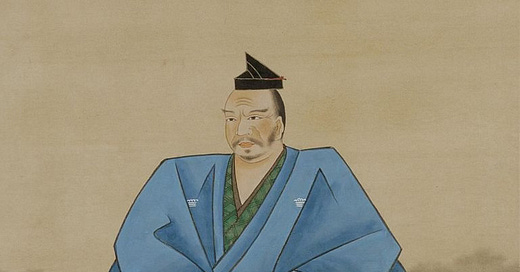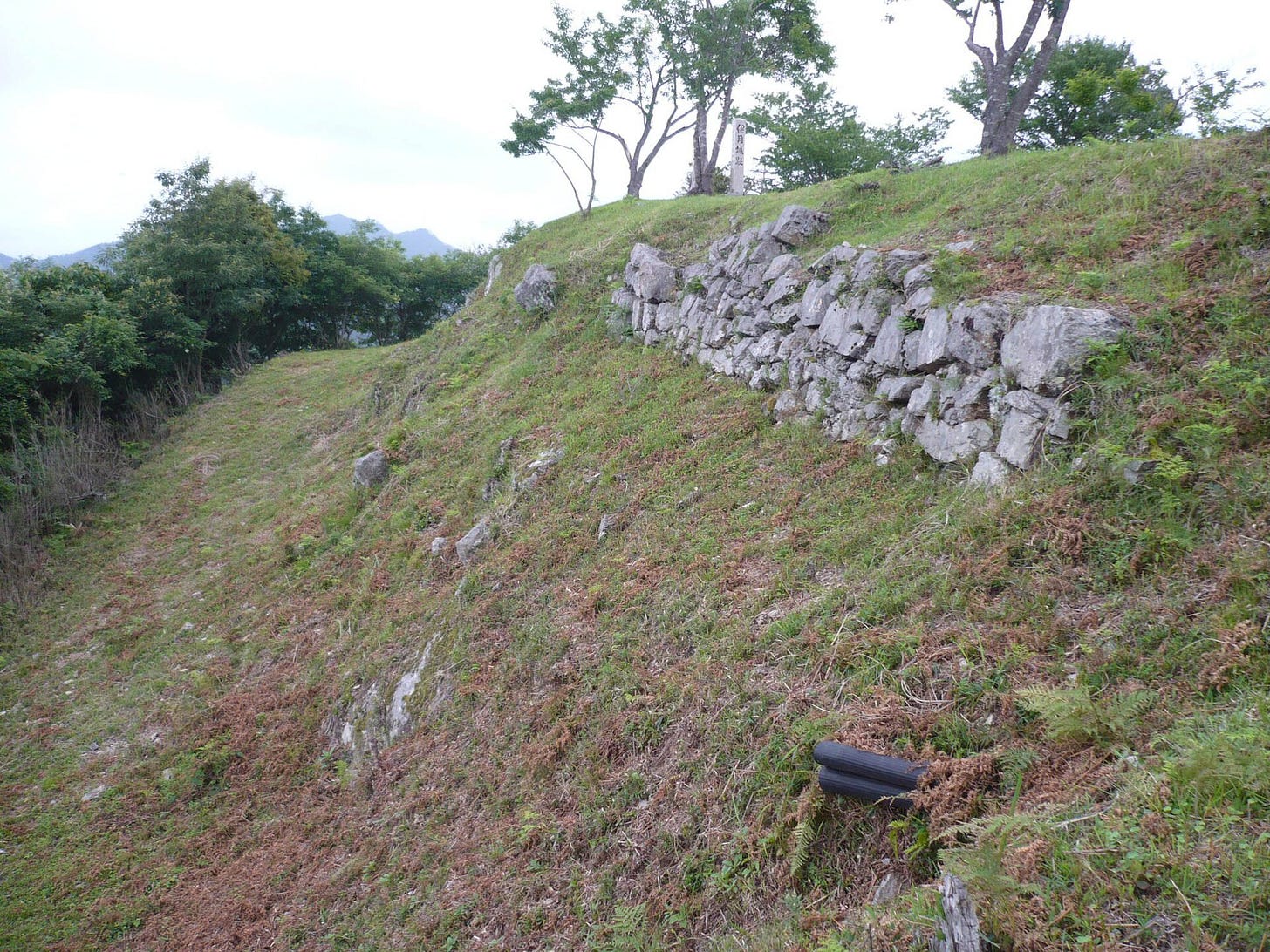The Hatano clan were powerful warlords that maintained control of southern Tamba Province (central far eastern Hyogo Prefecture) for four generations, beginning from when Hatano Kiyohide was given territory in Tambataki County by Hosokawa Masamoto in the late Muromachi period, until their downfall at Yakami Castle in 1579. The most famous of these men was the fourth generation lord, the Sengoku period to the Azuchi-Momoyama period warlord, Hatano Hideharu, (波多野 秀治 1541 – June 25, 1579) who is remembered as the lord of Yakami Castle, the last head of the Tamba Hatano clan, and as an unfortunate military commander.
Hideharu was born in 1541 as the eldest son of Hatano Motohide, also believed to have been known as Harumichi, although the name does not appear in any remaining records.
As head of the Hatano clan, Hatano Motohide supported Hosokawa Harumoto in his conflict against Miyoshi Nagayoshi, one of the most influential figures in Sengoku period history and puppet-master controller of the central shogunate. In 1557, Yakami Castle was attacked, taken and occupied by Miyoshi Nagayoshi’s retainer Matsunaga Nagayori, forcing the Hatano clan, Harumichi and his son Hideharu into exile. In October 1560, a certain Hatano Uemon — believed to be Motohide’s son, Hideharu — was sent to Kyoto to support Hatakeyama Takamasa the daimyo of Kawachi Province, who was also an enemy of Miyoshi Nagayoshi. This Uemon's younger brother was reported as killed in the ensuing battle.
Later, with the help of Ogino Naomasa, lord of Kuroi Castle, and the powerful Bessho clan, the Hatano attacked and recaptured Yakami Castle in February of 1566, and once again expanded their influence throughout the Tanba region.
In 1568, when Oda Nobunaga marched on Kyoto with the overthrown 15th and final Ashikaga Shogun, Ashikaga Yoshiaki in an attempt to restore him to power, the Hatano clan allegiances leaned towards the Oda clan. Hideharu established a friendship with Nobunaga, presenting him with swords and horses and around the time Hideharu succeeded his father, received a gift in return from Nobunaga on November 24, 1570. However, as the relationship between Nobunaga and the Shogun Ashikaga Yoshiaki deteriorated, Hideharu abandoned Nobunaga and sided with the Shogun, Ashikaga Yoshiaki, who was by now allied with Nobunaga’s rival warlords, the Mori clan.
In October of 1575, Oda Nobunaga sent his right-hand-man, Akechi Mitsuhide into Tamba to defeat Kuroi Castle’s lord, Ogino Naomasa. Mitsuhide advanced into Tamba Province, and initially gained the support of several local lords, including Hatano Hideharu, the lord of Yakami Castle, who pledged loyalty to the Oda. Mitsuhide then laid siege to Kuroi Castle, constructing 12 or 13 fortified encampments around the castle to cut supply lines, slowly exhausting the defenders' supplies through attrition leading to surrender. However, on February 14, 1576, the supposedly allied Hatano Hideharu, suddenly reneged, launching surprise attacks on the Oda force’s rear flank. The Akai and Hatano had effectively lured Akechi Mitsuhide and the Oda forces deep into Tamba territory before turning on him, launching a devastating counterattack on multiple fronts.
Forced into an embarrassing retreat, Mitsuhide withdrew from Tamba back to Sakamoto Castle. Mitsuhide managed to recover and once again attacked the Tamba region. This time, the fight for Tamba continued for several years, culminating in Mitsuhide’s eventual conquest of Tamba in 1579, and successfully capturing Yakami Castle and Hatano Hideharu.
The story goes that Akechi Mitsuhide offered to allow Hatano Hideharu to surrender safely and with dignity, and as collateral, took Hatano Hideharu’s mother as a hostage to Nobunaga as proof of Hideharu’s submission. The Hatano matriarch was duly brought to Azuchi Castle and before Nobunaga, who promptly had her executed. The samurai of Yagami Castle then somehow captured Mitsuhide's mother and killed her in revenge, supposedly sparking the animosity that would lead to Mitsuhide seeking revenge against Nobunaga, and his attacking the Honno-ji Temple and killing Nobunaga six years later.
This story regarding Akechi Mitsuhide's mother, although seemingly plausible, is highly questionable. There is a distinct lack of contemporary evidence. Mitsuhide’s mother’s grave is in Ena, Gifu Prefecture and there is no such information as to her ever having been a hostage or killed. This has been proven to be simply an Edo period fiction.
What actually happened is that the fighting gradually spread throughout Tamba, and during the siege of Yakami Castle that began in 1578, the castle’s supplies began to run low, causing the castle’s garrison to split into two factions, those for resistance and those for peace. Hideharu was finally captured by the peace faction and duly handed over to Akechi Mitsuhide, effectively breaking the siege.
Hideharu and his two younger brothers, Hatano Hidenao, and Hatano Hideka, were sent to Azuchi via Kyoto, and it is said that all three were executed —crucified — just outside Jion-ji Temple below Azuchi Castle. The grave of Hatano Hideharu in Ajimoku, Tanba Sasayama City, Hyogo Prefecture, is inscribed “Died in battle on the 6th month, 10th day, 6th year of Tensho (June 25th, 1579). Incidentally, the Shincho Koki, Chronicles of Lord Nobunaga, states that the crucifixion took place on the 4th day of the old lunar calendar, (modern equivalent of June 19) but since Yoshida Kanemi apparently witnessed the crucifixion while passing through Kyoto on the 6th, the date given in the Kanemi Kyoki diaries as June 21st is also considered possible.
While it could be argued that Hatano Hideharu was a dis-loyal opportunist, ready to make and break alliances at whim, it was not such a rare occurrence in Sengoku period Japan. Survival, and advancement of the clan were the priority, and life was a gamble with very high stakes on the table.






Fun post - this is a great story. Hatano Hideharu's death and its fallout inspired a bunch of local legends in and around Tanba Province, which were later adapted by kōdan oral storytellers, and even later came into the orbit of 'ninja' history. I wrote about one of them in some length a while back: https://open.substack.com/pub/criticalninjatheory/p/manabe-rokuro-the-ninja-who-wasnt?r=7j99t&utm_campaign=post&utm_medium=web&showWelcomeOnShare=false
If I'm not mistaken at least Japanese crucifixion was a bit less brutal than Roman one since they would spear the poor fellow instead of having him slowly suffocate due to chest muscles spasm.